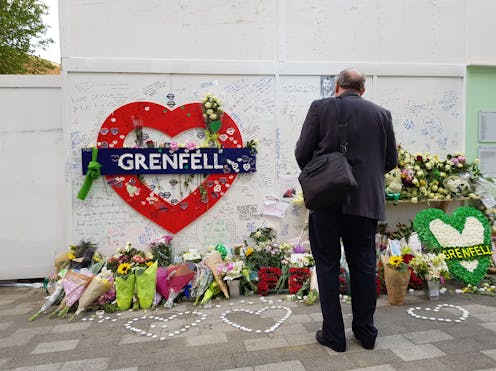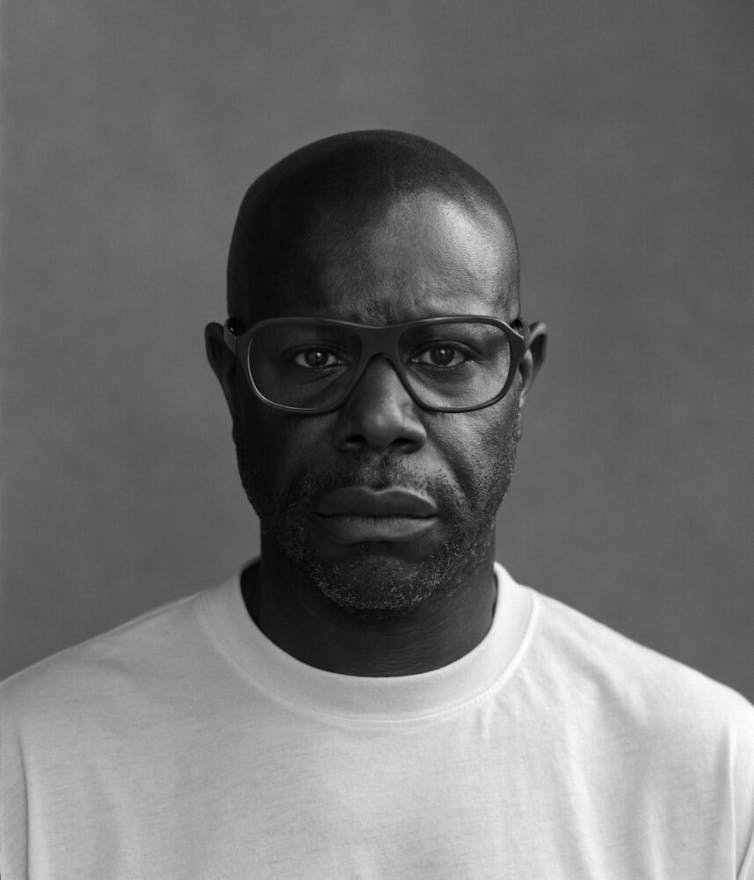
Oscar-winning artist and filmmaker Steve McQueen’s new work, Grenfell, is on show at London’s Serpentine Gallery. The 24-minute film – which the artist captured by helicopter in December 2017, six months after the fire – rotates around the Grenfell Tower in silence.
The fire at west London’s Grenfell Tower broke out in the early hours of the morning, on 14 June 2017. Seventy two people died. A government inquiry was launched, but the recommendations of the first phase of the report have yet to be implemented. The second phase is expected later this year. Six years on, residents, survivors and families are still campaigning for justice and the criminal investigation is ongoing.
McQueen’s project aims to ensure that Grenfell “lives on in the mind of the nation and the world long after the covering went up”. It challenges Britain’s history of forgetting its atrocities.

Grenfell has no narration, characters or dramatisation. It was self-funded and will not be sold, nor broadcast. As I sit and watch the camera rotate around the burned shell of the tower, time stops. I notice every shallow inhalation I take while imagining the unimaginable.
Remembering the people of Grenfell
The film begins with aerial footage of a green landscape. The sounds of the helicopter add to the cacophony of birds and the thrum of life below. As the camera passes over the green hills, sirens can be heard from afar. Rows of houses replace the rural landscape and then, in the distance, three towers stand tall. As the camera approaches the buildings, the middle tower becomes distinctive.
All sounds of life disappear and the audience is forced to witness the aftermath of death. If there were any doubts about the destruction caused by the fire, then the film reveals its true desolation.
Each devastating detail is memorialised as the camera rotates around the tower. The audience is made to look through the spaces of where windows once were, while the proximity allows us to see into rooms where people died.
Grenfell seemed to be quickly erased from public memory for the majority and it seemed to all but disappear from the political agenda once the burned building was covered up with white plastic.
In the exhibition notes, McQueen, who grew up on the nearby White City estate, explains:
When I heard about the fire, I needed to do something … I feared once the tower was covered up it would only be a matter of time before it faded from the public’s memory. In fact, I imagine there were people who were counting on that being the case. I was determined that it never be forgotten. So, my decision was made for me. Remember.
The narrative is not focused on statistics, policies or even safety regulations – McQueen’s film invites a different pathway to remember the 72 people whose lives were stolen from within the apparent safety of their own homes.
Rather than attempting to dramatise the various stories of the residents of Grenfell, the film blurs the line between documentation and artwork.
Accountability and justice
McQueen’s film responds to American philosopher and activist Susan Sontag’s call to “Let … atrocious images haunt us.” Through the process of haunting shown in McQueen’s film, the tragedy of the fire at Grenfell cannot be forgotten.
The report from the final phase of the government’s inquiry into the cause of the fire is set to be published later this year. But for many, there is still a sense of no accountability or justice for the families, survivors and communities surrounding Grenfell.
In her bestselling book, Why I’m No Longer Talking to White People About Race, journalist Reni Eddo-Lodge writes that: “faced with [the] collective forgetting” of Britain’s racist and violent history, “we must strive to remember”.
In Feminism Interrupted, writer Lola Olufemi explains: “Art is best utilised as a weapon, a writing back, as evidence that we were here.” Steve McQueen’s new artwork does exactly this. It is provocative because it implicates everyone who watches it, by asking them to bear witness, by not “letting them off the hook”. It demands that we remember that the residents of Grenfell were here.
Grenfell by Steve McQueen is showing at the Serpentine Gallery in London until Wednesday 10 May 2023. After this, the work will be placed in the care of Tate and the Museum of London’s collections.
Vanessa Macaulay does not work for, consult, own shares in or receive funding from any company or organisation that would benefit from this article, and has disclosed no relevant affiliations beyond their academic appointment.
This article was originally published on The Conversation. Read the original article.







